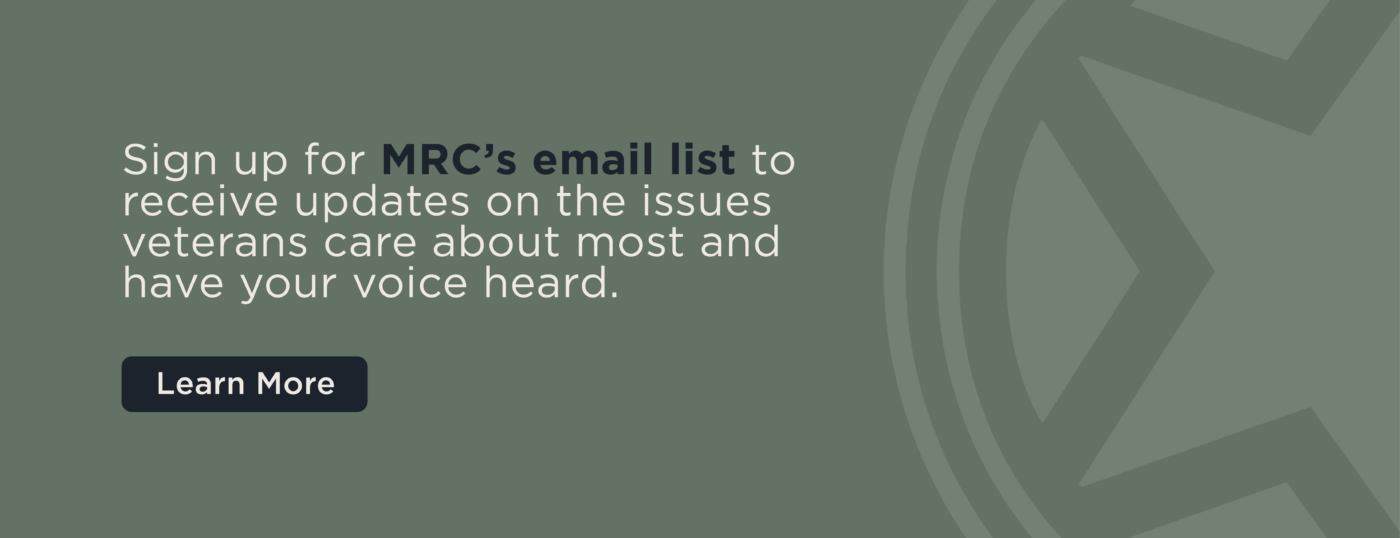The State of Rural and Tribal Veterans [2024]
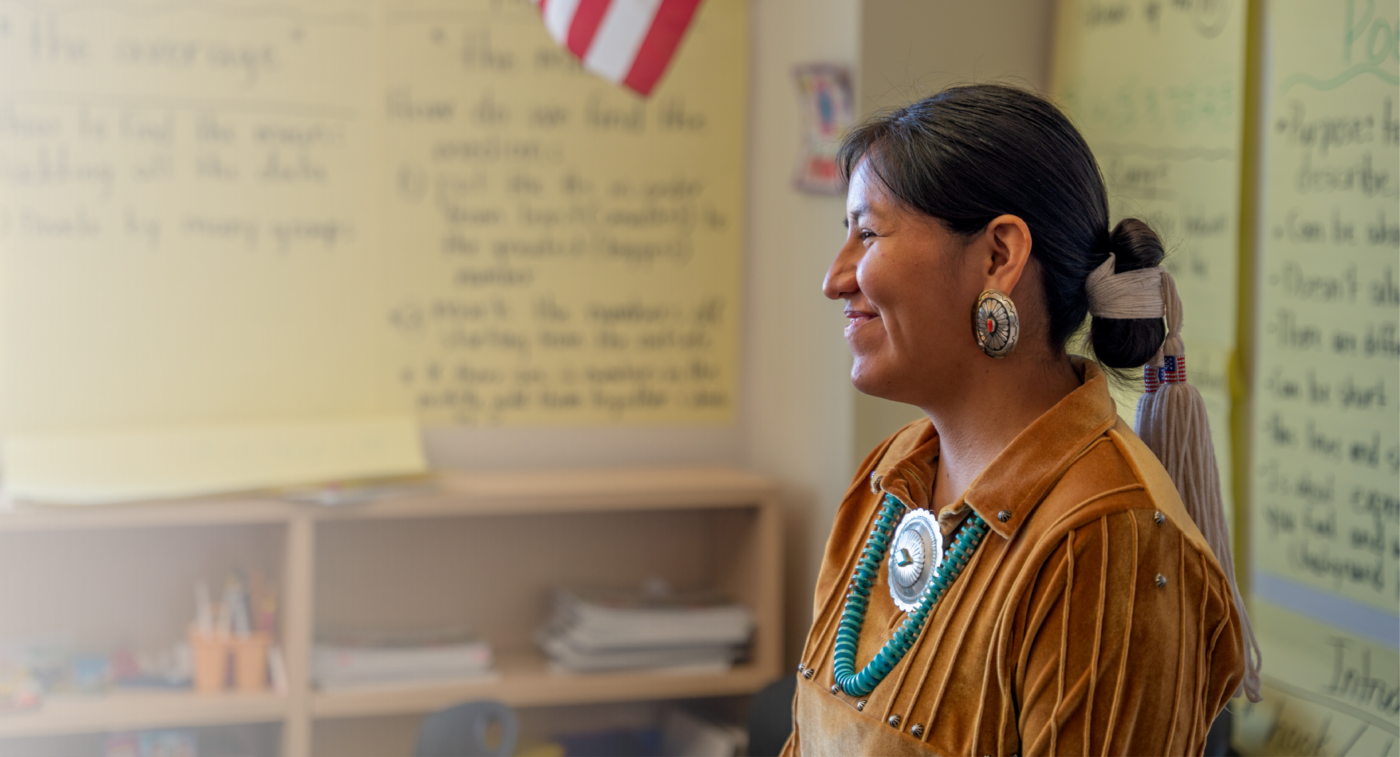
Rural and tribal veterans have played a significant role in the U.S. Armed Forces. Yet these underserved communities often face unique challenges in accessing the care and support they need after their time in service.
More than four million veterans reside in rural communities across the country. This includes many Indigenous veterans, who serve in the U.S. military at higher rates than any other group. Providing comprehensive, high-quality care to these veterans is a challenge, leading to further health disparities among these communities.
Mission Roll Call acts as a unified voice to educate lawmakers about issues surrounding access to timely and effective care, while amplifying voices of underserved veterans in rural and tribal areas. Since our founding in 2019, we’ve worked tirelessly to bring attention to the needs of these veteran communities.
In this article we will discuss:
- How many veterans live in rural areas?
- Why is access to care so important for rural veterans?
- Who are tribal veterans?
- What are the health care challenges facing tribal veterans?
- What is the suicide rate among rural and tribal veterans?
- What is the VA doing for underserved veterans?
- How can we support underserved veterans?
How many veterans live in rural areas?
Rural veterans represent a significant proportion of the nation’s veteran community. According to the United States Department of Veterans Affairs (VA), of the more than 18 million United States veterans, nearly a quarter of them – 4.4 million – live in rural areas. Veterans are more likely to live in rural areas than Americans who did not serve in the military.
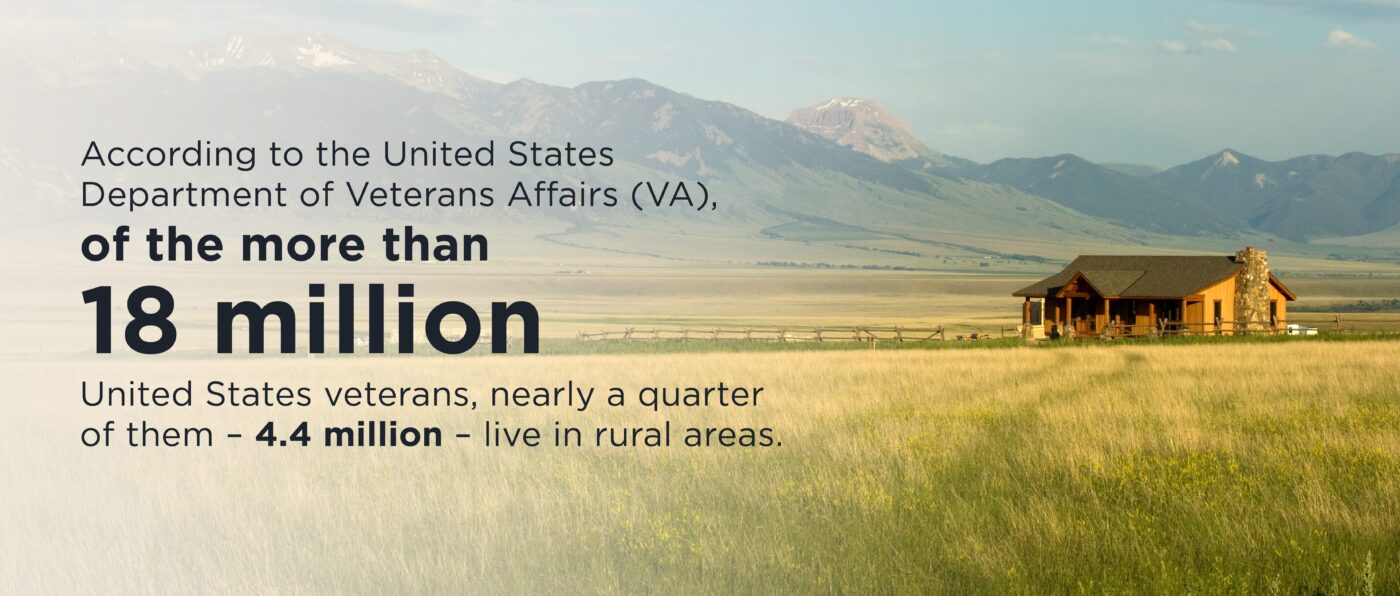
Veterans choose to live in rural areas because these areas typically have a lower cost of living; because they want to be closer to family, friends and community; because rural areas offer more land and space; and because some veterans seek less crowded areas to protect their mental health. The states with the highest concentration of veterans are Alaska, Wyoming, Virginia, Maine, Montana and South Carolina.
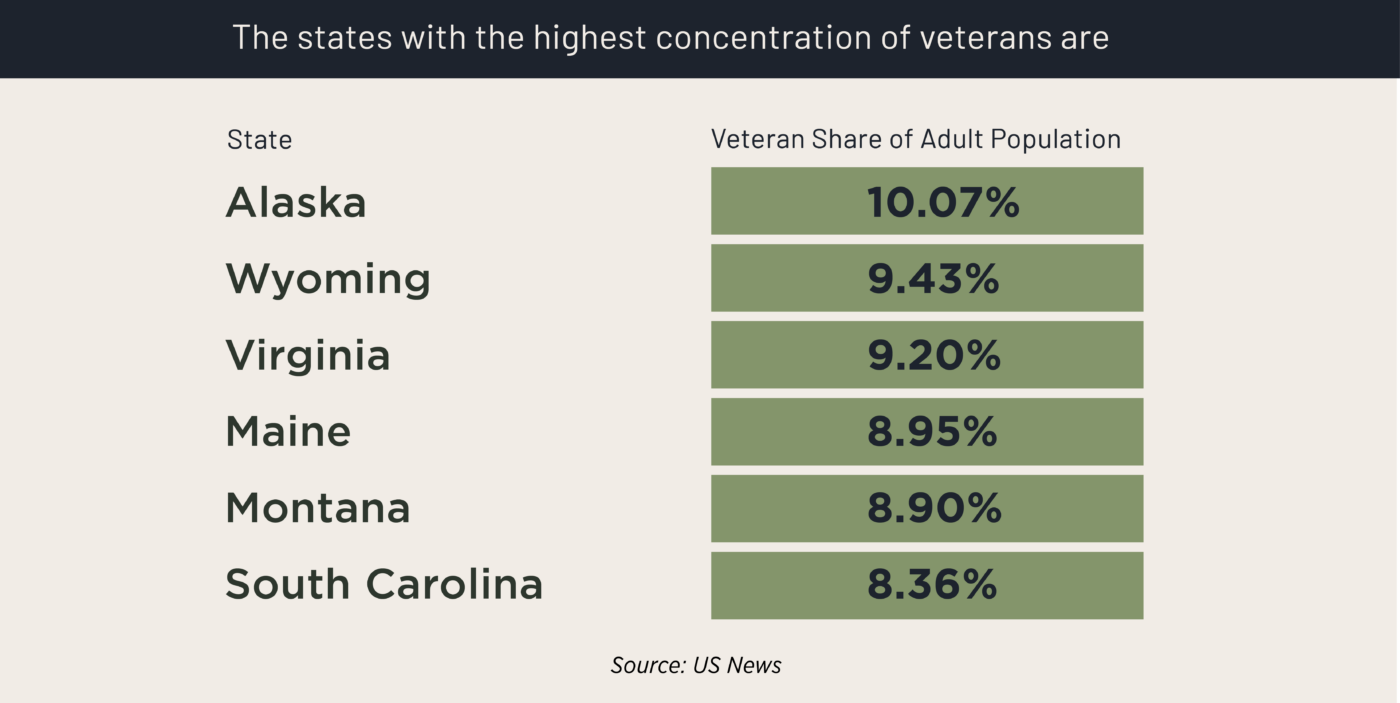
There are fewer health care providers and nurses per capita in rural areas, and rural veterans do not always live near VA health care services, which may be one of the reasons why only 2.7 million rural veterans are enrolled in the VA. But access to health care is critical for these veterans especially.
Why is access to care so important for rural veterans?
Access to preventive care and emergency services is vital, but it is harder to access for many living in rural areas.
Access to all types of care is important for rural veterans especially because:
- More than a quarter of rural veterans do not access the internet at home, meaning they are not able to access telehealth services or health-related information. And many do not even have a primary care provider.
- Many rural veterans are at an advanced age, with 56% age 65 or older.
Rural veterans are more likely to be diagnosed with diabetes, high blood pressure, obesity, and heart conditions. These conditions require more frequent, ongoing, and costly care.
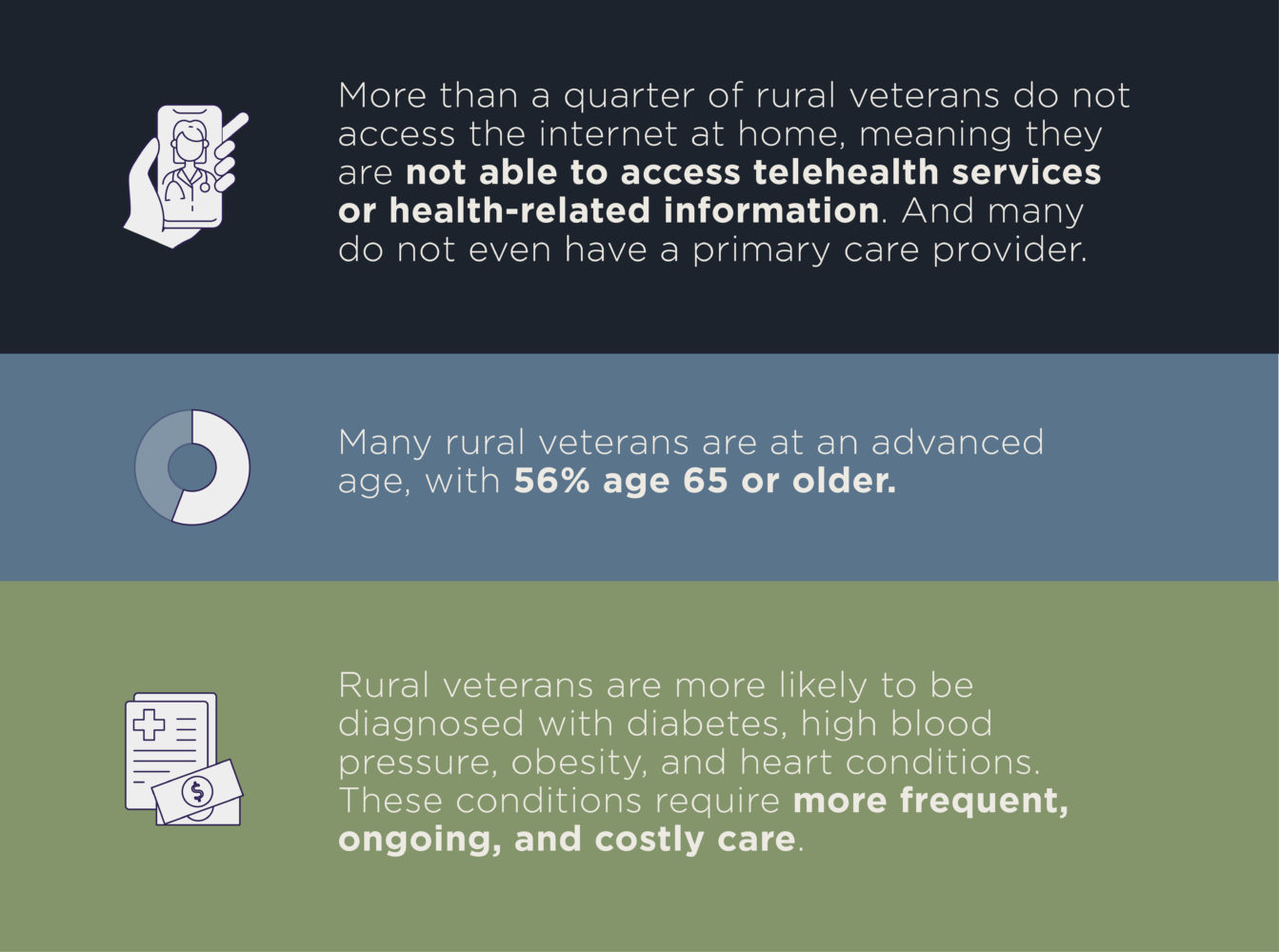
Additionally, rural veterans have lower average household incomes than other veterans, with more than half earning an annual income of less than $35,000. To put this in perspective, in 2023, the poverty threshold for a family of four in the U.S. was $30,000. The cost of travel to reach health care services can be extremely difficult for veterans on a fixed income.
Rural veterans may have higher rates of substance abuse. A 2019 study found that rural veterans had slightly higher rates of admissions for opiate and injectable drug use disorders than urban veterans. Additionally, studies have found that rural veterans are less likely to get medication for opioid use disorder, less likely to initiate treatment for alcohol abuse, and 63% less likely to receive education on alcohol use.
Who are tribal veterans?
Native Americans are more likely than any other race or ethnic group to live in rural America. There are an estimated 160,000 Indigenous American Indian, Native Hawaiian, and Alaska Native veterans in the United States, and about 39% live in rural areas.
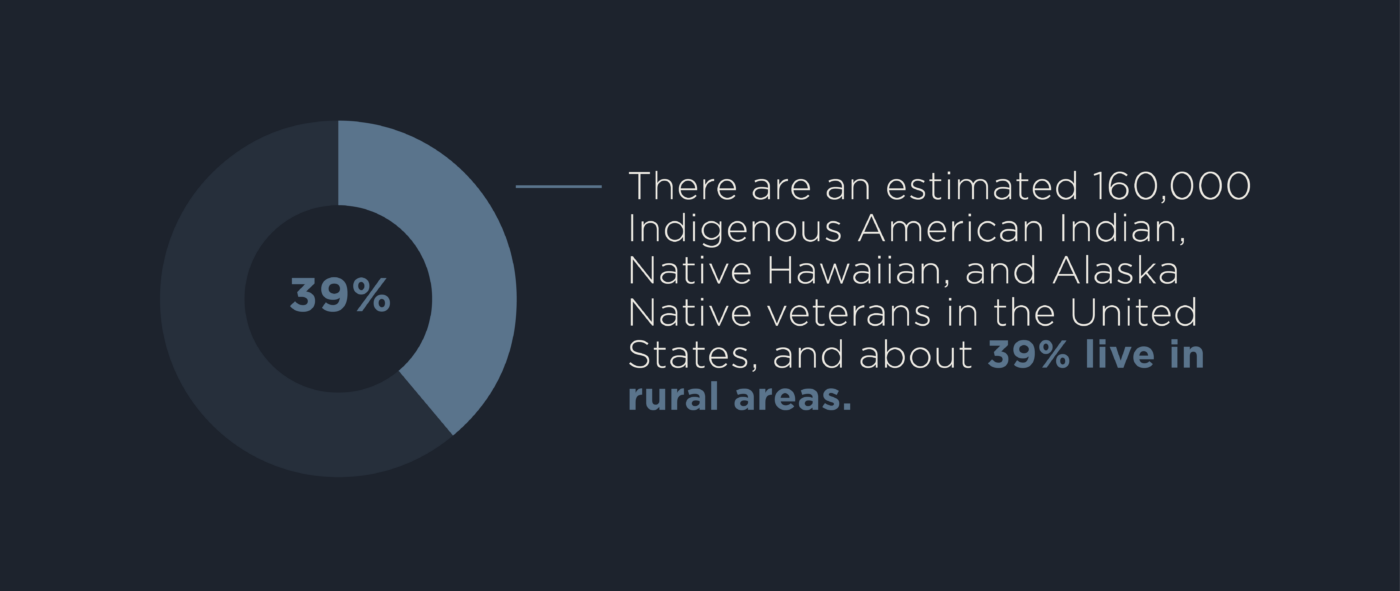
American Indians and Alaska Natives serve in the military at higher rates than any other group — five times the national average –– and have the highest per-capita service rate of any population. To date, 29 Native Americans have been awarded the Medal of Honor, our nation’s highest military honor.

At Mission Roll Call, we use the term “tribal,” though we recognize there are several terms used to describe Indigenous people, including Native American, American Indian, or the names of the many communities within this ethnic group. We have incorporated a few of these with respect to the information referenced and in hopes of highlighting the diversity among Indigenous veterans.
Tribal veterans have bravely served in every major conflict from the Revolutionary War to our most recent conflicts in the Middle East. For example, it is estimated that up to a quarter of all Native American men served in World War I, even in the face of racism.
What are the health care challenges facing tribal veterans?
Whether returning from service to live on reservations, in rural communities, or in urban environments, many Native American service members are experiencing gaps in veteran care that are exacerbated by unique socioeconomic factors.
Today, 326 American Indian reservations are home to about one-quarter of American Indians and Alaska Natives. Residents of these areas continue to deal with a poor quality of life, such as a lack of adequate cooking equipment, plumbing, and air conditioning.
Tribal veterans living both inside and outside of reservations often have lower incomes, lower education levels, and higher unemployment than veterans of other ethnicities. According to the VA, they are also more likely to lack health insurance and have a disability – service-related or otherwise.
Native American health is disproportionately worse than other racial groups in the U.S., with extremely high rates of heart disease, diabetes, and cancer.
- According to the Centers for Disease Control (CDC), 22.4% of American Indian and Alaska Native adults are considered to be in fair to poor health.
- Close to one-quarter (24.1%) of adults in this demographic are uninsured.
- Although almost three-quarters (74.3%) of American Indian and Alaska Native service members are enrolled in VA health, Indigenous veterans living in rural areas often have trouble accessing care because VA facilities are backlogged or far away.
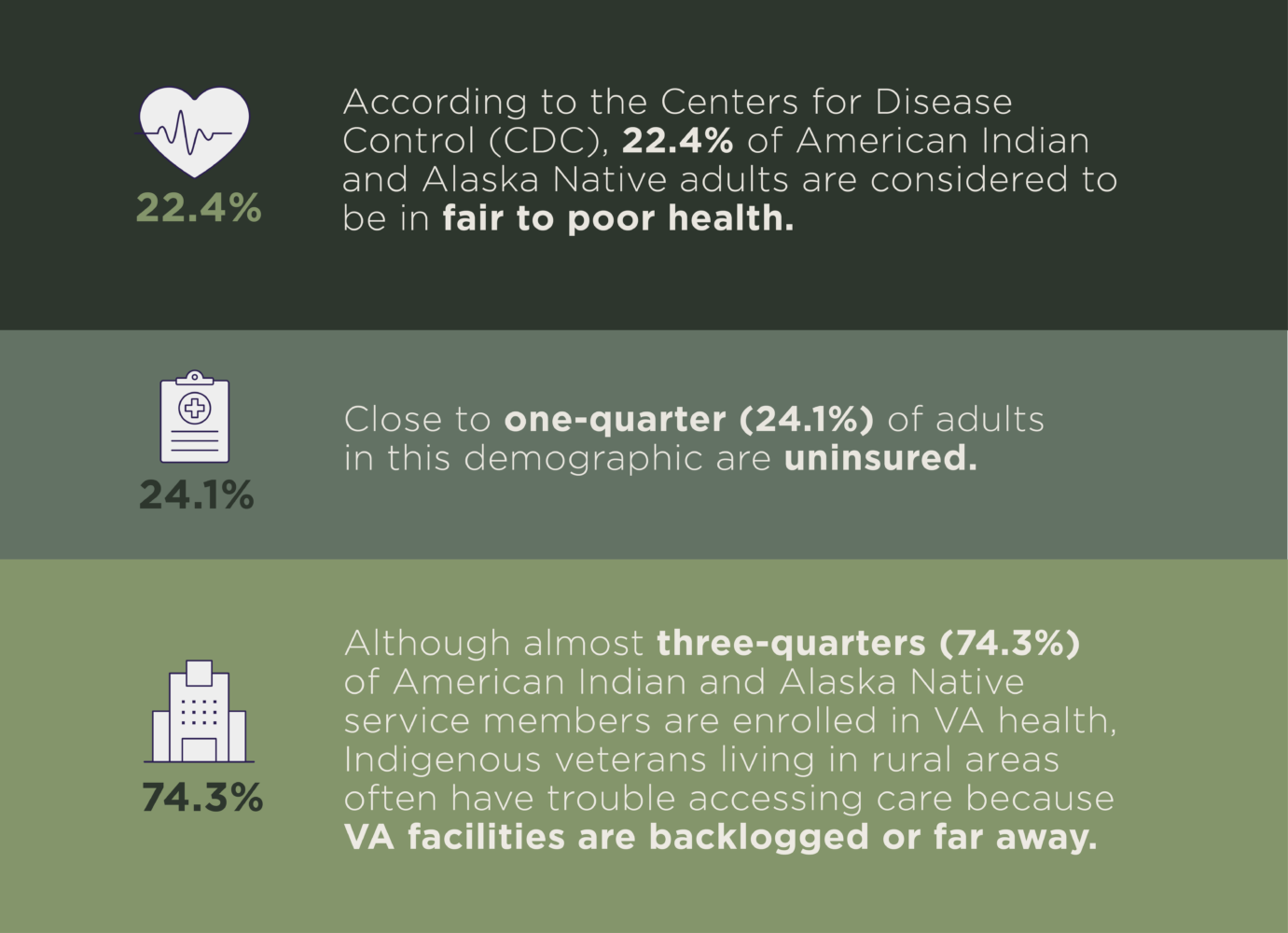
Additionally, Native American service members have often described military experiences as “spiritually isolating” due to judgments or ignorance around their unique customs. In fact, they were not legally allowed to practice their religion until 1978 with the passage of the American Indian Religious Freedom Act (AIRFA), and gaps in faith services for Indigenous service members have persisted.
What is the suicide rate among rural and tribal veterans?
Suicide rates among rural veterans are higher than rates among urban veterans. Veterans living in rural areas (who use VA’s healthcare system) are 65% more likely to die from suicide than those in urban areas.
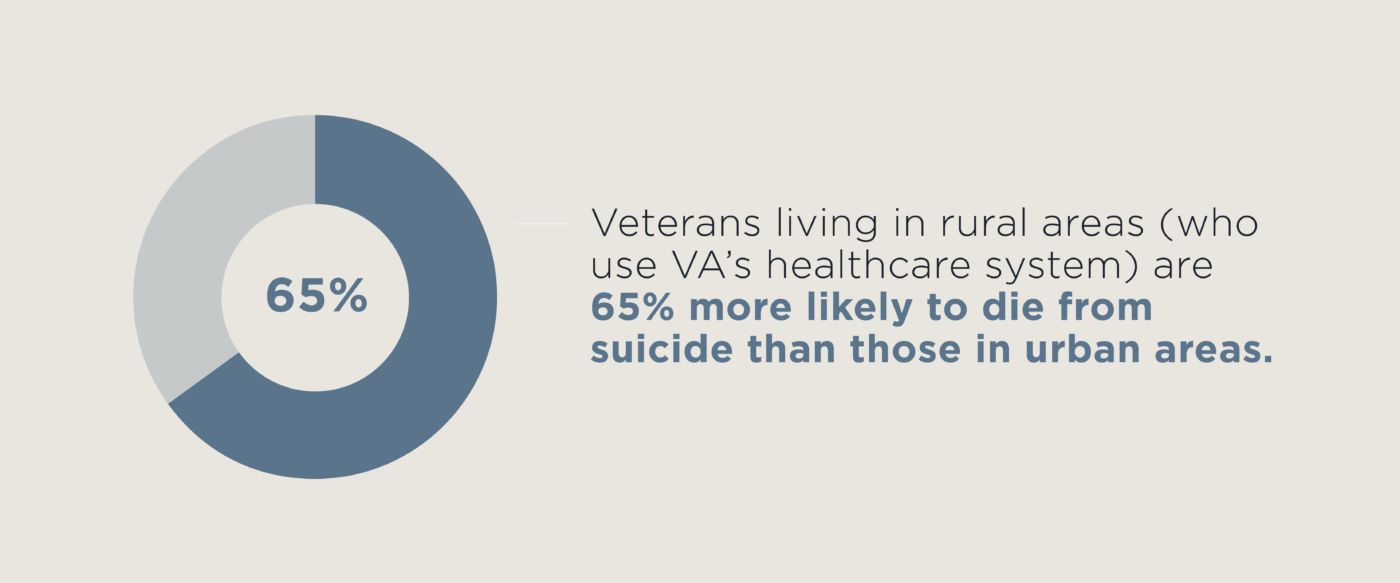
There are varied reasons for this, but VA findings show veterans living in rural areas are less likely to have access/transportation to care, are less likely to receive regular health exams, and are more likely to own a firearm. Additionally, rural veterans report that one barrier to mental health services is the perception in their community that seeking help for mental health is an admission of weakness.
Additionally, Hispanics, American Indian and Alaska Natives are experiencing a growing disparity. Among rural veterans, American Indian and Alaska Natives have twice the risk for suicidal ideation compared to White veterans. And rural residence is associated with a 41% increase in suicide risk among Hispanic veterans.
Indigenous people have the highest suicide rates of all ethnic groups in the U.S. Factors such as cultural stigmas, substance use, social isolation, poverty, limited access to health care, and high unemployment rates play a role, along with experiences unique to Indigenous people around historical trauma and discrimination.
For Indigenous service members returning home from their time in service, the numbers are particularly concerning. In 2021, the suicide rate was 46.3 per 100,000 for American Indian or Alaska Native veterans, compared to 36.3 per 100,000 for White veterans.
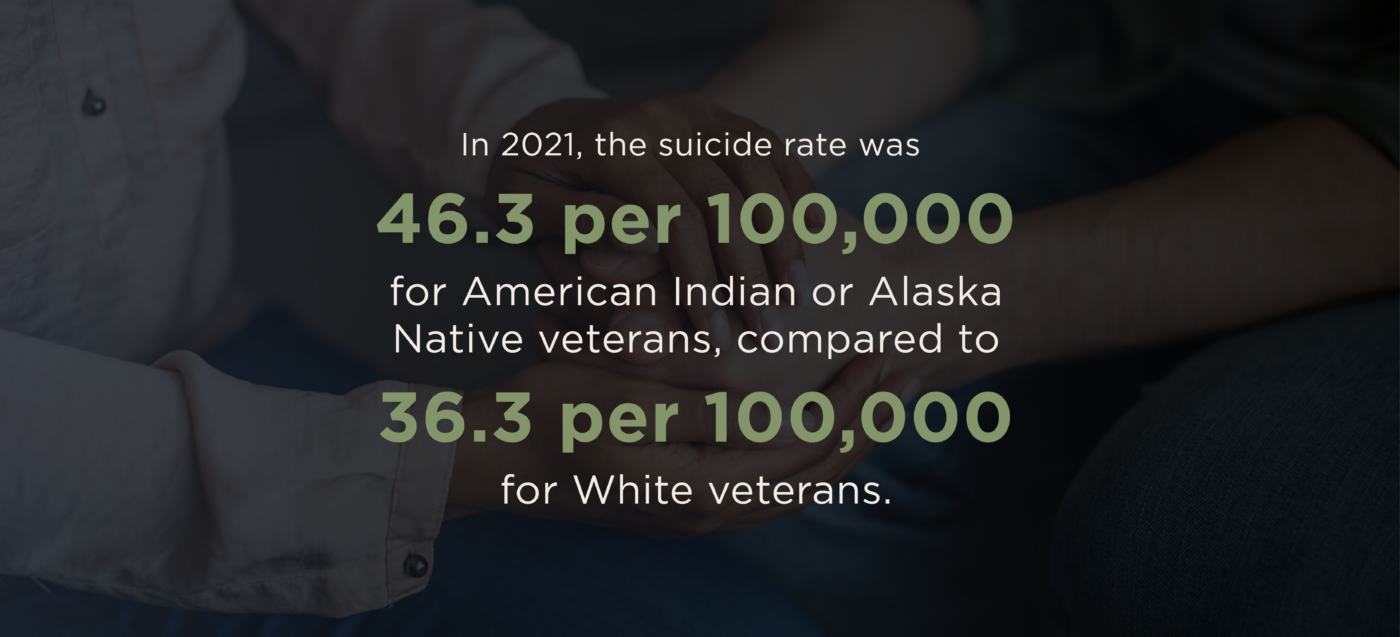
What is the VA doing for underserved veterans?
The VA’s Connected Care Program seeks to bring broadband access to more rural places with limited capacity, in order to support remote virtual care. Additionally, the VA and Walmart have partnered to offer telehealth services to reach underserved veterans. This is important because according to the Secretary’s Center for Strategic Partnerships, 90% of Americans live within 10 miles of a Walmart.
On June 6, 2018, the VA MISSION Act was signed into law, becoming effective June 6, 2019. The MISSION Act strengthens the VA’s ability to deliver veterans’ care virtually through telehealth, and through community care providers.
In recognizing the unique socioeconomic and environmental factors among rural and tribal veterans, the VA is seeking to incorporate more “culturally tailored” initiatives. For example, in the Native American veteran community, this includes providing alternatives to clinical exam rooms and consulting with tribe leaders for outreach. It is also developing community partnerships with state and local community services and agencies to improve mental health among underserved communities.
In 2022, the VA released a notice for its Tribal Representation Expansion Project that seeks to establish greater collaboration with tribal governments to expand opportunities for claims representation where needed.
How can we support underserved veterans?
The first step toward supporting these communities is educating ourselves on the unique challenges they face, and how stereotypes of these communities may impact how we perceive them and the care they receive.
Here are three ways you can support underserved veterans:
- Mission Roll Call has identified and vetted many nonprofit organizations that work with these communities. For example, The Alaska Warrior Partnership™ (AKWP) is committed to improving veterans’ quality of life in the state of Alaska through the coordination of local services and opportunities. And Boulder Crest Foundation provides a free, first-class rural wellness retreat dedicated to helping America’s military members, veterans and their families.
- Most legislation that would help these communities are not stand-alone pieces of legislation (for example, the MISSION Act was primarily designed with rural veterans in mind). However, there are some important bills in Congress right now:Commitment to Veteran Support and Outreach Act: This bill would provide grants to states and Indian tribes for programs that improve outreach and assistance to veterans and their families.Not Just a Number Act: This bill requires the VA to analyze and report on which benefits and services from the VA have the greatest impact on suicide prevention among veterans.
VA Emergency Transportation Access Act: This bill would ensure that the VA maintains fair, transparent ground and air ambulance rates – especially important for rural veterans.
- Point veterans you know to Mission Roll Call. Signing up to receive our newsletter and participate in polls helps us advocate for the issues that are most important to the veteran community, especially underserved veterans.
Mission Roll Call has also been advocating and facilitating the placement of ATLAS telehealth pods in tribal and rural communities to expand care options for both of these groups, which historically have lower access to the internet. When you join MRC, you will be helping us in this effort and others.
Conclusion
Many veterans – especially those in rural and tribal communities – face significant barriers in accessing essential resources – from health care and mental health services to employment and housing. Addressing these challenges requires a tailored and multi-faceted approach, including policy reforms, increased funding for community-based, veteran-specific programs, and stronger support networks.
Geographic isolation, limited access to health care, and cultural barriers can significantly impact both physical and mental health. It is our country’s duty to not only recognize veterans’ sacrifices but to also actively work toward creating more inclusive and effective opportunities for care for all veterans – both at the federal level and the community level.
By dedicating resources and attention to these underserved populations, we can bridge the gap in services and support that has impacted the veteran community for decades.
